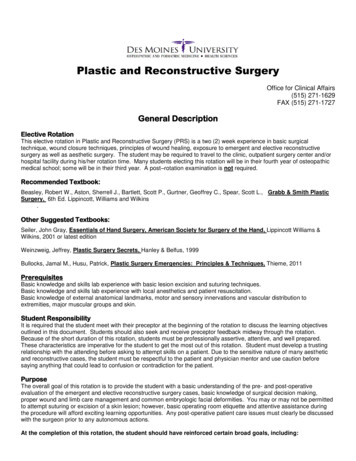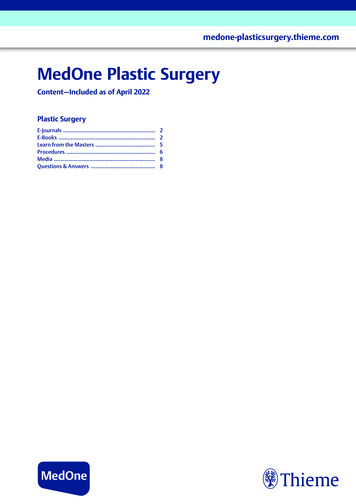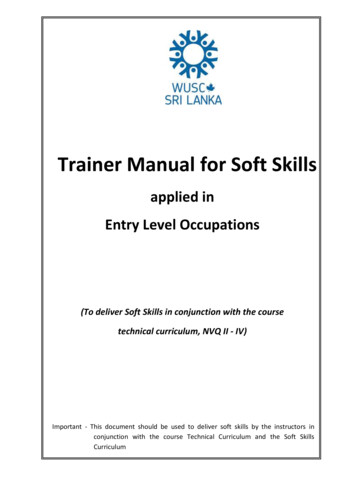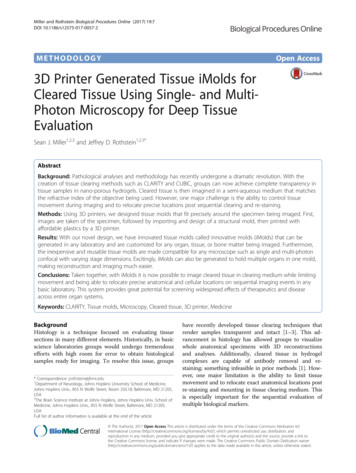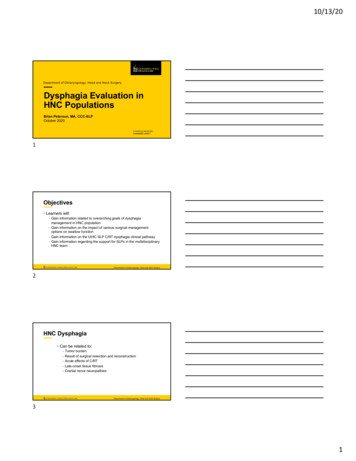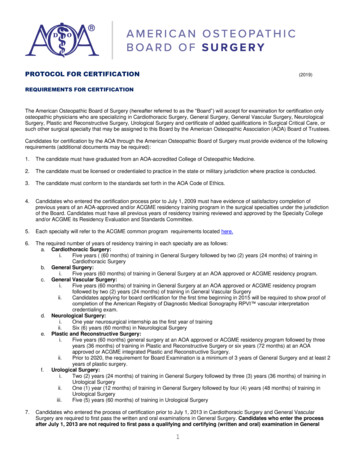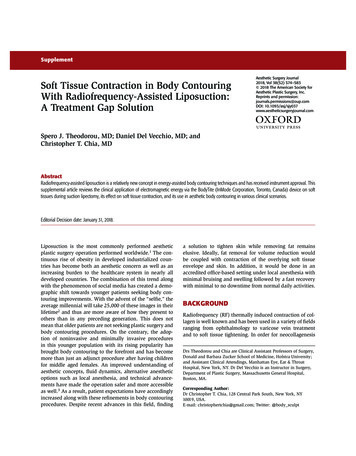
Transcription
SupplementSoft Tissue Contraction in Body ContouringWith Radiofrequency-Assisted Liposuction:A Treatment Gap SolutionAesthetic Surgery Journal2018, Vol 38(S2) S74–S83 2018 The American Society forAesthetic Plastic Surgery, Inc.Reprints and permission:journals.permissions@oup.comDOI: pero J. Theodorou, MD; Daniel Del Vecchio, MD; andChristopher T. Chia, MDAbstractRadiofrequency-assisted liposuction is a relatively new concept in energy-assisted body contouring techniques and has received instrument approval. Thissupplemental article reviews the clinical application of electromagnetic energy via the BodyTite (InMode Corporation, Toronto, Canada) device on softtissues during suction lipectomy, its effect on soft tissue contraction, and its use in aesthetic body contouring in various clinical scenarios.Editorial Decision date: January 31, 2018.Liposuction is the most commonly performed aestheticplastic surgery operation performed worldwide.1 The continuous rise of obesity in developed industrialized countries has become both an aesthetic concern as well as anincreasing burden to the healthcare system in nearly alldeveloped countries. The combination of this trend alongwith the phenomenon of social media has created a demographic shift towards younger patients seeking body contouring improvements. With the advent of the “selfie,” theaverage millennial will take 25,000 of these images in theirlifetime2 and thus are more aware of how they present toothers than in any preceding generation. This does notmean that older patients are not seeking plastic surgery andbody contouring procedures. On the contrary, the adoption of noninvasive and minimally invasive proceduresin this younger population with its rising popularity hasbrought body contouring to the forefront and has becomemore than just an adjunct procedure after having childrenfor middle aged females. An improved understanding ofaesthetic concepts, fluid dynamics, alternative anestheticoptions such as local anesthesia, and technical advancements have made the operation safer and more accessibleas well.3 As a result, patient expectations have accordinglyincreased along with these refinements in body contouringprocedures. Despite recent advances in this field, findinga solution to tighten skin while removing fat remainselusive. Ideally, fat removal for volume reduction wouldbe coupled with contraction of the overlying soft tissueenvelope and skin. In addition, it would be done in anaccredited office-based setting under local anesthesia withminimal bruising and swelling followed by a fast recoverywith minimal to no downtime from normal daily activities.BACKGROUNDRadiofrequency (RF) thermally induced contraction of collagen is well known and has been used in a variety of fieldsranging from ophthalmology to varicose vein treatmentand to soft tissue tightening. In order for neocollagenesisDrs Theodorou and Chia are Clinical Assistant Professors of Surgery,Donald and Barbara Zucker School of Medicine, Hofstra University;and Assistant Clinical Attendings, Manhattan Eye, Ear & ThroatHospital, New York, NY. Dr Del Vecchio is an Instructor in Surgery,Department of Plastic Surgery, Massachusetts General Hospital,Boston, MA.Corresponding Author:Dr Christopher T. Chia, 128 Central Park South, New York, NY10019, USA.E-mail: christophertchia@gmail.com; Twitter: @body sculpt
Theodorou et al S75Table 1. Patient InformationNo. of patients312GenderFemale265 (84.9%)Male47 (15.1%)Average age, years31.4Average BMI, kg/m223.2BMI, body mass index.to occur, the dermal and soft tissue components need tobe heated to a range of 60 to 80 C3 and approximately 40to 42 C on the skin surface.4 There is an optimal temperature range where restructuring of these fibers occurs asopposed to tissue destruction and coagulation. Whereasmultiple modalities such as laser and ultrasound havebeen purported to be effective,5-8 we present our experience with the BodyTite (InMode Corporation, Toronto,Canada) device (Table 1), where electromagnetic radiationis applied directly to the soft tissues. Radiofrequency energyis transmitted from a generator device platform (Figure 1)to a directional handpiece (Figure 2). An internal probe islocated in the subcutaneous adipose layer and the externalprobe makes contact with the skin. All the soft tissue inbetween the electrodes is treated with the RF. The continuous RF is applied with a continuous movement of the handpiece, thus delivering a uniform energy to a large area.Efficient heating of the treated soft tissue is achieved witha high degree of safety that restricts the internal and external temperature. This allows for efficient energy depositionwhich shortens operative time when compared to othermodalities attempting to heat the same volume of tissueto a target temperature. These characteristics of this particular RF energy platform have led to its use in the field ofbody contouring where tissue laxity is a challenge. On volumetric analysis, soft tissue linear contraction, describedas the “fibro-septal network” response to RF energy, hasbeen described as high as 47% with thickening of the collagen matrix on histological examination of skin biopsiessix months postoperatively. In the same study, Blugermanet al reached an average local linear contraction of 31%that is statistically significantly higher than that reportedwith other energy-emitting liposuction technologies.9The ability of RF to affect significant contraction of thesoft tissue increases the potential patient population whomay not have skin laxity severe enough to warrant a standard excisional operation but will likely have a poor aesthetic outcome with liposuction alone due to overlying skinelasticity deficiency. There is a large number of these “inbetween” patients in this “gap” category that their clinicalpicture presents as “not bad enough for an excisional procedure and not good enough for liposuction.” Specifically,Figure 1. Radiofrequency energy generator platform(InMode Corp., Toronto, Canada).areas of the body described as zones of nonadherence10such as the arms, neck, and medial thighs may be amenable to radiofrequency-assisted liposuction (RFAL) for satisfactory contouring who otherwise would be turned awaywith liposuction alone by the judicious surgeon. The RFALtechnology, being more effective and directed at fat resection, can be achieved with an increased margin of safetysince the skin can be anticipated to retract more than withmanual suction-assisted lipectomy (SAL) alone.5 In a studycomparing aggressive superficial liposuction with RFALin arm sculpting,11 the results were suggestive that resultswere superior with RF (although the sample size was toosmall to reach statistical significance.) It has been noted
S76 Figure 2. BodyTite handpiece (InMode Corp., Toronto,Canada).that even in experienced hands that rate of complications,especially of contour deformities, with superficial liposuction is much higher.12 In our experience, we found RFALcan achieve consistent and reproducible results with excellent soft tissue contraction but without the complicationrates of aggressive, superficial liposuction.DEVICEThe hand-held hand piece transmits the RF energy from thegenerator platform (BodyTite, Toronto Canada) betweentwo electrodes; the internal electrode is placed in the subcutaneous adipose layer and the external electrode is incontact with the skin. The device received FDA approvalin 2016 with the indication of electrocoagulation of soft tissues. The RF energy alternates between the internal electrode and the external electrode through the skin layers. RFdensity is higher around the smaller internal electrode thanaround the larger external one. In this arrangement, heating is selective, with lower temperature on the skin surfacefor safety while temperatures reached are higher inside thefat layer. This also achieves highly efficient and controlledenergy deposition to only the tissue in between the electrodes and obviates the need for a grounding pad (Figure 3).The RF energy transmitted between the two electrodesinduces coagulates of fat and contraction of the fibroseptal network (FSN), causing retraction of the soft tissue flapthrough later neocollagenesis.5,9 The device is measuring inreal time the amount of energy deposited during the treatment as well as the external and internal temperatures ofthe tissue (Figure 4), as well as tissue impedance. The goalfor the external temperature is to reach 40 to 42 C. Once theend point of 40 to 42 C surface temperature is reached, RFis disabled and the treatment is terminated. Once the tightening portion of the treatment is finished, this is followedby suction-assisted lipectomy for contouring purposes, ifnecessary. For smaller areas of the face (FaceTite) and forsoft tissue tightening where fat removal is not required,liposuction is not performed. It is noted, however, that inareas of significant heat deposition outside of the face andpossibly neck, where the volume of the fat coagulated bythe device is anticipated to be 100 mL, it is important toremove the liquefied end products with a small amount ofAesthetic Surgery Journal 38(S2)liposuction even though contouring is not required. This isdone to remove the heated fluids that otherwise would poolin the operated areas and increase the risk of subsequentseroma formation and fat necrosis. This is due to the considerable amount of residual heat in both the treated softtissues and tumescent fluid that remains after the treatmentfor that area has been completed.Significant safety features have been included into thedevice platform due to the considerable amount of energythat is applied to the tissues in between the electrodes tominimize the risk of thermal injury. Real-time impedanceand temperature monitoring is provided by both the internal and external electrodes so that goal temperatures areachieved and maintained for the time required. Once thegoal temperature is achieved, the device automatically stopsenergy delivery. As in any energy-based body contouringdevice, the risk of burn and seroma exist. In one study ofthe first-generation, pre-FDA approved device, there was a6.25% incidence of thermal injury and 8.3% minor complication rate (seromas, etc.)13 In our current experience ofthe new generation, FDA-approved device used in approximately 100 operations, we have not seen any complicationsto date.14 Conversely, maintaining the temperature and tissue heating at goal ensures efficacy and mitigates the riskof undertreatment. An additional safety feature is that thedevice continuously monitors the rate of temperature riseso that if a significant temperature increase or spike occurs,energy delivery stops. This feature is called temperaturesurge protection. From a practical standpoint, the platformgives audio feedback so that the surgeon will know whenthe temperature is within two degrees of goal by a doubletime bell signal, as well as when the tissue is heated at goaltemperature (triple time bell) and the energy delivery isstopped. This way, the surgeon does not have to look at thescreen to know what the temperature is and can maintainhis focus on the patient at all times.ANESTHESIAAlthough RFAL may be performed under intravenous sedation or general anesthesia, it is ideally suited for local anesthesia for small, discrete areas in properly selected patients. Theoperation is performed with excellent analgesia using oralmedications such as diazepam, hydrocodone/acetaminophen, and antibiotic safely and comfortably. Irrespective ofthe mode of anesthesia, the subcutaneous fat space requirestumescent fluid to provide an adequate space in which theinstrument travels, as well as the proper turgor of the overlying soft tissues to ensure satisfactory coupling of the externalprobe to the skin. In addition, the water in the tumescentfluid aids in good RF conductivity and in the internal probetreating at the appropriate depth. For example, adequate tissue turgor is achieved when a sufficient volume of tumescent
Theodorou et al S77Figure 3. Idealized image of the internal electrode in thesubcutaneous adipose layer and the external electrode on theskin depicting radiofrequency energy passing through thesoft tissues in between.Figure 4. Image of the user-interface screen on the BodyTitegenerator platform. Note the external and internal cut-offsettings and temperature reading outputs.solution is injected to result in complete and thorough analgesia. It is important to provide a minimal space of severalmillimeters between the internal probe and the subdermisto avoid “bad coupling” and impedance mismatches whichcould result in thermal injury (burn). The high specific heatof water provides a secondary source of heat to the soft tissues as the retained higher temperatures of the tumescentfluid continues to transfer heat long after the application ofthe RF energy has been completed.Higher concentrations of lidocaine are required for comfort and an isotonic solution of 1000 mg of lidocaine withsodium bicarbonate (to buffer the acidic pH) and 1.5 cc of1:1000 concentration for epinephrine is used for tumescent.The American Society of Plastic Surgeons guideline maximum lidocaine load for tumescent liposuction of 35 mg/kgbody weight15 is followed. This results in a well-toleratedprocedure with a short recuperative phase (back to dailyactivities within a day) and an excellent safety profile.16Table 2. Arm Classification Scheme Identifying Degree of Laxity into SixCategories (types) With Proposed TreatmentAPPLICATIONS IN PLASTIC SURGERYArmsArm contouring remains a challenge in our field. Mainlydue to the dependent nature of the fat and skin in this anatomical area. Brachioplasty has been our mainstay treatment for this area, when there is laxity not amenable totraditional liposuction surgery. However, the positioningof the scar and the nature of it lends itself to a high visibility problem for many patients and thus not a viablesolution. This “gap” in treatment offering has limited armcontouring with brachioplasty to a relatively small numberof patients, according to ASAPS statistics approximately15,000 a year.1 It has been postulated that energy-assistedASLASQAdiposityTreatmentType IMildGood Not RFAL candidateType IIModerateGood SAL/LALType IIIModeratePoor RFALType IVSevereGood RFALType VSeverePoor RFAL staged skin excisionType VISeverePoor BrachioplastyASL, arm skin laxity; ASQ, arm skin quality; LAL, laser-assisted liposuction; RFAL, radiofrequency-assisted liposuction; SAL, suction-assisted lipectomy.liposuction of the arm has led to increased contractionwhen ultrasound energy has been used. In addition,aggressive subdermal liposuction with its claims of skincontraction runs a high risk for contouring defects. RFAL isa new nonexcisional technique that lends itself to superiorresults in group of patients that we never had a solutionfor.17 In order to properly treat these types of patients theauthors devised a road map in the form of a new classification scheme11 (Table 2) that takes into account not onlyskin laxity but also skin quality and amount of adiposity present. When approaching these types of patients theoperator has to address the arm like a cylinder or a garment requiring “taking in” for proper redraping. The concept of an internal brachioplasty scar is advanced througha proper amount of energy delivery along the newly coinedtriceps midline meridian line (TMM) (Figures 5 and 6).The excess scarring along this line serves as a recruitmentpoint for excess redundant tissue just as it would for abrachioplasty. The portion of the arm contributing to arm
S78 Aesthetic Surgery Journal 38(S2)Figure 5. Schematic representation of the triceps midline meridian (TMM) concept indicating where most of theradiofrequency energy is deposited in order to cause radial contraction of the arm.laxity is divided into two zones where the majority of theRF energy is delivered. This is followed by 270 liposuction sparing the area of the bicipital groove where the vessels and nerves lie (“no man’s land”). Once discontinuousundermining is performed via SAL the excess tissue contracts around the “internal brachioplasty” line (ie, TMMleading to redraping of the soft tissue envelope).AbdomenThe postpartum abdomen presents a series of challengesfor plastic surgeons. Ranging from addressing laxity, whento perform liposuction and when to avoid, repairing diastasis recti and so on. One of the most difficult decisionshowever, to address is the patient that presents with postpartum infraumbilical laxity, no diastasis (or minimal),lack of C-section incision and is not bad enough for anexcisional procedure (ie, abdominoplasty). These patientsare emphatic in their wishes to not have a scar but complain of skin laxity, especially when they are in the flexedposition (pic). These “gap” patients are typically goodcandidates for RFAL on condition that they have enoughadipose tissue to provide an intact FSN for heating andretraction.18 The ability to effectively treat this particularproblem opens the door to a large number of patients thatwould otherwise never consider any plastic surgery treatment due to their fear of having a scar (Figures 7 and 8).Medial ThighsThe medial thigh region has always been an area that a lotof patients complain about when visiting their surgeon.The media push about the need to have a “thigh gap” as asign of beauty and sexual attractiveness has only exacerbated the request for body contouring in this region. Theneed to explain to patients the need for a very conservative approach when addressing this area with liposuctionhas been the standard teaching principal in all trainingprograms around the country. Unfortunately the “thighgap” is not just related to the amount of fat in the medialthighs but also to the anatomic alignment of the underlying musculoskeletal framework and as such is not necessarily amenable to operative correction. This triangulararea that is formed by the medial thigh adipose tissue andbuttock confluence has led many a surgeon astray withdismal results when trying to achieve. In simple terms itis the “Bermuda Triangle” of lower extremity liposuction.The reason behind this fact, is that the medial thigh regionis an area of nonadherence and as such it’s at high risknot only for residual iatrogenic laxity but also for contour deformity. The correction for over resection in bestof cases is with autologous fat grafting and in worst ofcases a medial thigh lift. The resulting scar is not acceptable in any case and the main reason why patients withmedial thigh laxity avoid seeing a plastic surgeon or do notproceed with surgery. RFAL when used judiciously in thisarea, in the right patient, can allow the operator to be moreaggressive with the fat resection. The reason being is thatthe heat generated by the RF platform will allow greaterretraction of the soft tissue envelope and address the laxitythat tends to plague this anatomical area.NeckThe anterior neck and jawline are also amenable to contouring by fat removal and skin tightening with RFAL in that
Theodorou et al S79ABCDFigure 6. A 40-year-old woman with Type IV arm. External temperature 42 C. (A, C) Preoperative and (B, D) 12 monthpostoperative photographs.the submental angle presents a challenge for the redrawingof the soft tissue coverings following liposuction.19 Due tothe acuteness of the angle, it can be prone to poor aestheticoutcomes if the support of the overlying skin is inadequatedespite maneuvers otherwise such as inflammation due tomanual suction, laser energy, or ultrasonic energy. Withthe deposition of RF energy, the relatively thin skin andsoft tissue must be accounted for with lower goal temperature settings. In addition, the subcutaneous space is alsopreplatysmal superficial to the muscle and, therefore, thesuperficial fascial system. The recruitment of soft tissuesin the neck are more limited in other areas of the bodywhich also adds to the difficulties in eliciting enough contraction to obtain a satisfactory submental angle.
S80 AAesthetic Surgery Journal 38(S2)BFigure 7. A 38-year-old, gravida 3 woman, with significant abdominal wall and skin laxity and refused abdominoplasty. (A)Preoperative and (B) 12 month postoperative photographs. A total of 2300 mL lipoaspirate was removed; external temperature,42 C.Anatomical landmarks for the areas of treatmentinclude the anterior border of the sternocleidomastoidmuscle laterally on both sides which demarcates theposterior extent of the treatment zone. Superiorly, theinferior border of the mandible is noted. It is not necessary to go above the mandible where the marginalmandibular nerve typically travels. The first cervicalcrease demarcates the inferior extent of dissection. Themidline is marked in line with the central incisors andthe fat excess topographically marked in the customaryfashion for liposuction. Three access incisions are madewith a 14-gauge needle for a circular puncture: one inthe midline submental crease and one behind each lobule. Approximately 250 to 300 mL of tumescent fluid isinjected providing analgesia and vasoconstriction. Next,the NeckTite device is used to heat the soft tissues withtypical goal temperatures of 36 C externally and 55 Cinternally for 15 to 30 sec per site. Small cannula liposuction is then performed to remove the heated fluids andfat for contouring. Nylon sutures 5-0 are used to close theaccess incisions and the patient is covered with hydratinggel and a compression bandage. Sutures are removed atabout one week postoperatively.Other ApplicationsDue to the considerable soft tissue matrix contractionelicited by the RF device, indications of its use includemastopexy where there is no skin excision.20 Via standard access incisions, strategically applied RF energy to thebreast can cause contraction of the superior pole of thebreast. This will, in effect, vertically raise the nipple-areola complex (NAC). This effect can be a possible application for moderate to mild ptosis (Grade I, Grade II) andearly results have been encouraging. Regarding the inferior pole of the breast, the midline soft tissue can be contracted with RF energy to shorten the transverse length inorder to reduce skin excess in that vector. Conversely, inthe male chest where volume is reduced in gynecomastiacases (Figure 9), RF energy is applied in order to preventsuperior rotation of the NAC as well as contract the inferiorpole skin where the fat and breast tissue is removed.
Theodorou et al S81ABCDFigure 8. A 35-year-old, gravida 2 woman with no significant diastasis. (A, C) Preoperative and (B, D) 12 month postoperativephotographs. A total of 1000 mL lipoaspirate was removed; external temperature, 40 C.
S82 AAesthetic Surgery Journal 38(S2)BFigure 9. A 28-year-old man with gynecomastia treated with radiofrequency-assisted liposuction (RFAL). (A) Preoperativeand (B) 12 month postoperative photographs.Target temperature of 42 C was achieved, and 500 mL lipoaspirate was removedbilaterally in total.DISCUSSIONWith increasing popularity and easy access to body contouring procedures, the indications of liposuction areexpanding to include both younger and older patients.It’s important to delineate the following when discussingthis type of technology. The ability to produce a mediocreresult without a scar might be better than a perfect resultwith a scar. This is in line with the limitations of the devicethat present in cases such as massive weight loss patientswho have irreversibly damaged dermal and fibro-septalnetwork and/or patients advanced in age. It’s true that thegold standard for face laxity is a facelift and for abdominal laxity it’s an abdominoplasty etc. However, having theability to treat a large segment of the population that couldbe borderline patients (most of whom would be turneddown) is a fact that should not be easily dismissed. Thosewith borderline elasticity (treatment gap patients) of theoverlying soft tissue present challenges in obtaining reliable, safe, and reproducible aesthetic outcomes. The reasonbeing that proper uniform skin retraction is not reliableonce the fat has been removed. Previous energy-baseddevices with purported soft tissue retraction claims havefailed to produce significant results.CONCLUSIONRFAL presents a novel application of electromagnetic energyin a unique delivery device that ensures both uniform andefficient heating of the soft tissues to target temperatureswhile including multiple safety parameters to greatly mitigate the risk of overheating and burns. The cost of acquiringthe device (like any technology platform) should always beweighed against the ability to not only attract new patientsbut also to provide or enhance consistently good results(Table 3). This has been the case in the authors’ experience with this device where a patient satisfaction surveyfollowing RFAL indicated that 89% of patients who underwent the procedure would recommend it. In addition, anindependent plastic surgeon evaluation of the results wasconsistently positive.13 Coupled with judicious patient selection and good body contouring, RFAL has the potential to
Theodorou et al S83Table 3. Financial ConsiderationsSimple economic model (financial assumptions)Device cost205,000 USDDisposable cost200 USDDown payment40,000 USDLease rate5%Lease term36 monthsCash revenue7000 USDCases/month1Cash on cash returns analysis (financial assumptions)Patient revenue7000 USDDisposable200 USDLease payment/month4925 USDProfit1875 USDelicit a 3-dimensional soft tissue contraction reliably andpredictably to both expand the base of otherwise not traditional liposuction candidates, as well as improve outcomesin patients for whom liposuction is an option. We believethat RFAL technology has the potential to deliver both.DisclosuresDrs Theodorou and Chia are shareholders in the InModeCorporation. Dr Del Vecchio is a co-founder and co-owner ofSurgistem Technology, LLC.FundingThis article was supported by the InMode Corporation(Toronto, Canada), who co-funded the development of thissupplement.REFERENCES1. Cosmetic surgery national data bank statistics. AesthetSurg J. 2017;37(suppl 2):1-29.2. Galuppo MM. Millennials expected to take over 25,000selfies in their lifetime. -lifeti/22099995. Accessed January 31, 2018.3. Chia CT, Neinstein RM, Theodorou SJ. Evidencebased medicine: liposuction. Plast Reconstr Surg.2017;139(1):267e-274e.4. Teruya TH, Ballard JL. New approaches for the treatmentof varicose veins. Surg Clin North Am. 2004;84(5):1397417, viii.5. Paul M, Mulholland RS. A new approach for adiposetissue treatment and body contouring using radiofrequency-assisted liposuction. Aesthetic Plast Surg.2009;33(5):687-694.6. DiBernardo BE, Reyes J, Chen B. Evaluation of tissuethermal effects from 1064/1320-nm laser-assisted lipolysis and its clinical implications. J Cosmet Laser Ther.2009;11(2):62-69.7. Rohrich RJ, Beran SJ, Kenkel JM, Adams WP Jr, DiSpaltroF. Extending the role of liposuction in body contouringwith ultrasound-assisted liposuction. Plast Reconstr Surg.1998;101(4):1090-1102; discussion 1117.8. Sasaki GH. Quantification of human abdominal tissuetightening and contraction after component treatmentswith 1064-nm/1320-nm laser-assisted lipolysis: clinicalimplications. Aesthet Surg J. 2010;30(2):239-245.9. Paul M, Blugerman G, Kreindel M, Mulholland RS. Threedimensional radiofrequency tissue tightening: a proposed mechanism and applications for body contouring.Aesthetic Plast Surg. 2011;35(1):87-95.10. Rohrich RJ, Smith PD, Marcantonio DR, Kenkel JM. Thezones of adherence: role in minimizing and preventingcontour deformities in liposuction. Plast Reconstr Surg.2001;107(6):1562-1569.11. Chia CT, Theodorou SJ, Hoyos AE, Pitman GH.Radiofrequency-assisted liposuction compared withaggressive superficial, subdermal liposuction of the arms:a bilateral quantitative comparison. Plast Reconstr SurgGlob Open. 2015;3(7):e459.12. Kim YH, Cha SM, Naidu S, Hwang WJ. Analysis of postoperative complications for superficial liposuction: a reviewof 2398 cases. Plast Reconstr Surg. 2011;127(2):863-871.13. Theodorou SJ, Paresi RJ, Chia CT. Radiofrequency-assistedliposuction device for body contouring: 97 patients underlocal anesthesia. Aesthetic Plast Surg. 2012;36(4):767-779.14. Ulvila D, Chia CT, Theodorou SJ, Radiofrequency-assistedliposuction: experience with generation II RFAL device asafety and efficacy study. Presented at the ASMLS AnnualConference 2018 in Dallas, TX; April 2018.15. American Society of Plastic Surgeons Committee onPatient Safety. Practice Advisory on Liposuction: sues/ExecutiveSummary-on-Liposuction.pdf. Accessed January 31, 2018.16. Chia CT, Albert MG, Del Vecchio S, Theodorou SJ. 1000consecutive cases of laser-assisted liposuction utilizingthe 1440 nm wavelength Nd:YAG laser: assessing thesafety and efficacy. Aesthetic Plast Surg. 2018;42(1):9-12.17. Duncan DI. Improving outcomes in upper arm liposuction: adding radiofrequency-assisted liposuction to induceskin contraction. Aesthet Surg J. 2012;32(1):84-95.18. Duncan DI. Nonexcisional tissue tightening: creatingskin surface area reduction during abdominal liposuction by adding radiofrequency heating. Aesthet Surg J.2013;33(8):1154-1166.19. Keramidas E, Rodopoulou S. Radiofrequency-assistedliposuction for neck and lower face adipodermal remodeling and contouring. Plast Reconstr Surg Glob Open.2016;4(8):e850.20. Duncan DI. Scarless scalpel free breast lifting advantages and limitations. ast-lifting-advantages-and-limitations.Accessed January 31, 2018.
in arm sculpting,11 the results were suggestive that results were superior with RF (although the sample size was too small to reach statistical significance.) It has been noted Table 1.atient Information P No. of patients 312 Gender Female 265 (84.9%) Male 47 (15.1%) Average age, years 31.4 Average BMI, kg/m2 23.2 BMI, body mass index. Figure 1.


